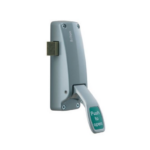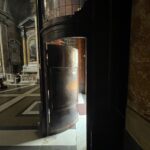This post was printed in the June 2011 issue of Doors and Hardware
[Click here to download a reprint of this article.]
Over the years, I’ve heard many people mention the rule of thumb that the rating of the fire door assembly is “3/4 of the rating of the wall.” Although the fire door rating is typically less than the rating of the wall, the 3/4 ratio doesn’t always apply. The required rating for a fire door depends on the type of wall assembly (fire wall, shaft, corridor, smoke barrier, etc.) and the wall’s required rating. These hourly ratings indicate the length of fire test exposure, and the duration of fire protection provided by the assembly.
The International Building Code (IBC) and NFPA 101 – The Life Safety Code each contain a table that specifies the fire door assembly rating for each corresponding wall assembly. For example, a fire wall with a 3-hour rating requires a fire door assembly with a 3-hour rating. A 1-hour rated smoke barrier wall requires a 20-minute rated door. The table from NFPA 101 includes the ratings for fire window assemblies as well as fire door assemblies. The IBC has separate tables for each – fire door assembly ratings are shown in table 715.4, and fire window assembly ratings are in Table 715.5 (2009 edition).
While we’re on the subject, people always ask me why the rating of the door isn’t the same as the rating of the wall. It’s because there’s the potential for a higher fuel load adjacent to the wall, for example, furniture, shelves, or stored items. The door should theoretically have no fuel load in direct contact. For this reason, NFPA 80 states that fire rated doors which are no longer used should be removed and replaced with the appropriate wall material rather than permanently closed. I recently went looking for some fire doors in a hospital and found them behind large bookcases!
Consult the tables below (or the applicable tables from your local codes) to determine the required rating of a fire door assembly.
From the 2009 edition of the International Building Code (IBC):
From the 2009 edition of NFPA 101 – The Life Safety Code:
Here’s the text from NFPA 80 Annex K in regard to the removal of unused fire doors:
K.5 Despite the provision of protection specified in this standard, walls with openings have less fire resistance than unpierced walls. Fire doors, shutters, and fire windows are designed to protect an opening under normal conditions of use, with a clear space on both sides of the opening. Where the opening is not used and combustible material is piled against the door, window, or shutter, the designed protection cannot be expected. For that reason, combustible material should be kept well away from openings. Where a door or window opening is no longer in use, the opening should be closed with construction having a fire resistance rating equivalent to that of the wall.
This post was originally created on March 6, 2009, and was printed in the June 2011 issue of Doors & Hardware magazine.
You need to login or register to bookmark/favorite this content.









Leave A Comment